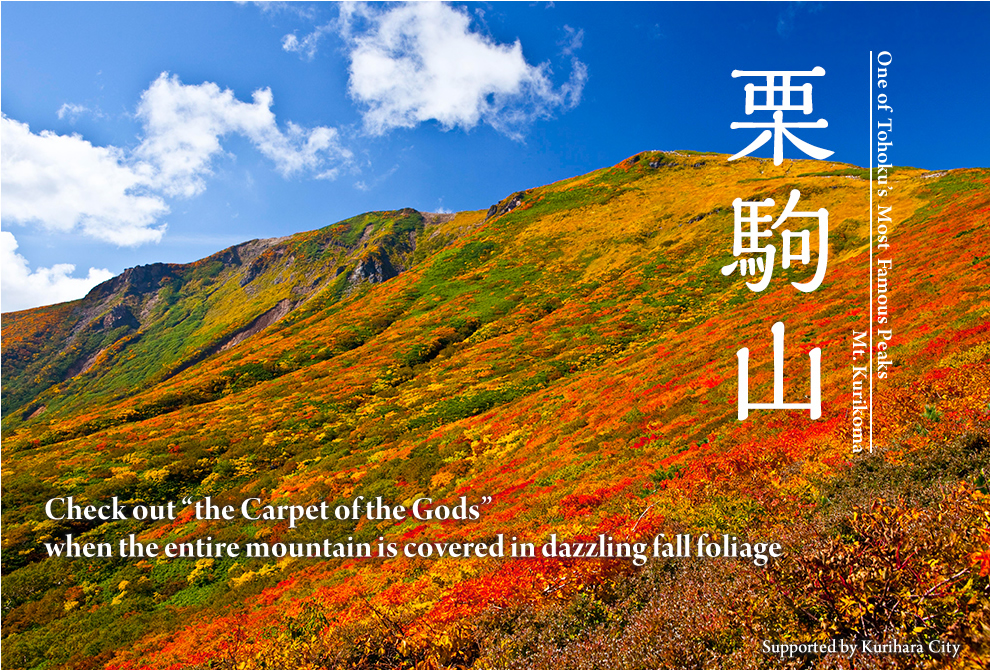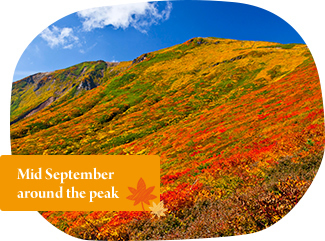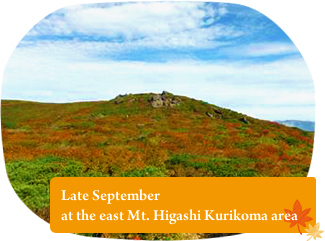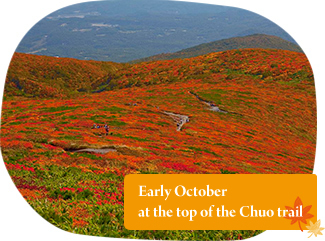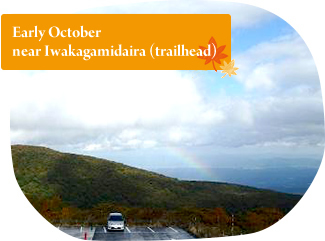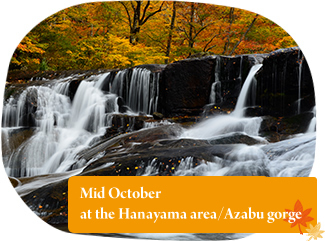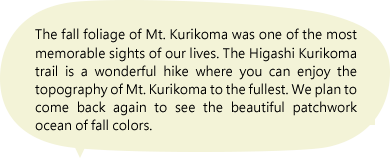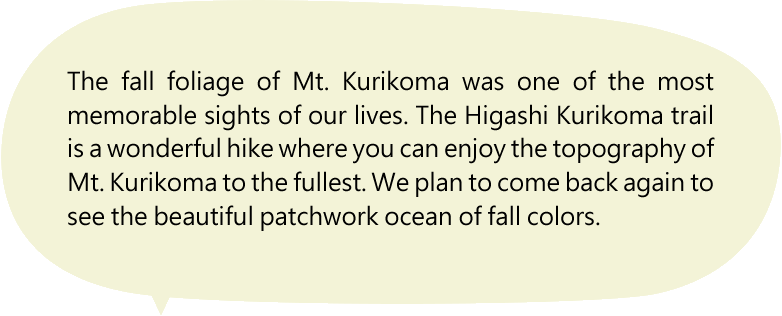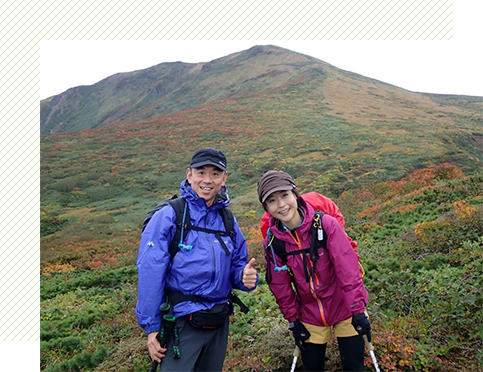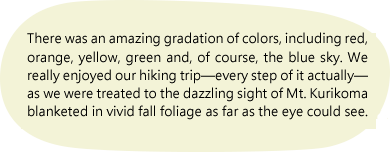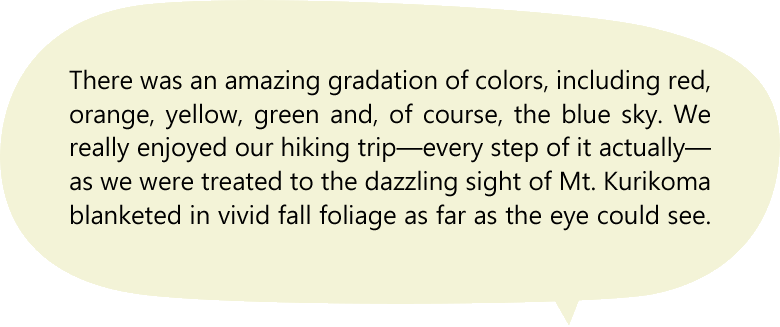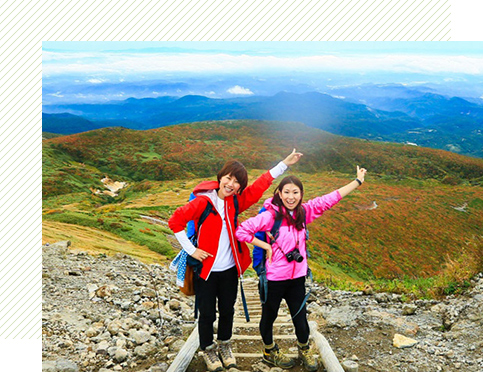Mt. Kurikoma (elevation 1626 meters) straddles Miyagi, Iwate and Akita prefectures. The mountain is known to be completely covered in dazzling fall foliage, with the prime viewing season spanning from late September to mid October.
The base of the mountain is also dotted with a number of outstanding hot springs. This autumn is your chance to check out the stunning fall foliage at Mt. Kurikoma.
Mt. Kurikoma’s fall foliage, places to see, and when to visit
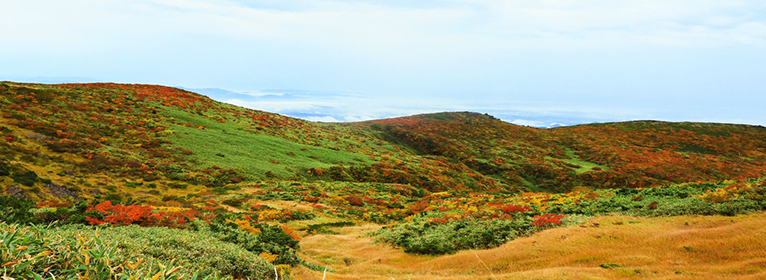 Photo = Miyuki NIshimura
Photo = Miyuki NIshimura
Mt. Kurikoma is located roughly in the middle of the Ou Mountain Range, straddling Miyagi, Iwate and Akita prefectures. This range is known for Mt. Kurikoma in Miyagi, Mt. Sukawadake in Iwate Prefecture and Mt. Dainichidake in Akita. From its 1,626-meter peak, Mt. Kurikoma affords views of many of Tohoku’s most famous peaks including Mt. Chokai, Mt. Gassan, Zao Mountain Range, Mt. Iwate, and Mt. Hayachine, among others.
Mt. Kurikoma is known for its abundance of alpine vegetation during the summer, so much so that it was selected as one of “Japan’s 100 most famous peaks for flowers.” The mountain’s deciduous broad-leafed forest of Japanese beech, Mongolian oak, and varieties of maple is stunningly beautiful both in the early summer and autumn. Mr. Kyuya Fukada, author of “One Hundred Mountains of Japan,” in the postscript said that he probably should have included Mt. Kurikoma in this list.
Mt. Kurikoma is also known for its many hiking trails leading to its peak, including six from the Miyagi Prefecture side, two from Iwate Prefecture, and one from Akita Prefecture. During the fall foliage season, hikers must carefully plan their ascent and descent because of the short day light hours. Generally, most hikers take the Chuo trail or the Higashi Kurikoma trail from Iwakagamidaira. Compared to the gently sloping trail with expanses of fall foliage and awesome views on the Miyagi Prefecture side, the trails from the Akita and Iwate prefecture sides traverse a ridgeline with the remains of the mountains volcanic activities and unique volcanic topography. Be sure to plan your hike based on your hiking ability and fitness level.
People refer to the sight of the mountain completely covered in fall foliage as “the Carpet of the Gods.” The colors begin from the peak around mid September and the gradually descend to the middle and foot of the mountain, with the fall foliage viewing season ending around mid October.
This autumn is your chance to plan a hiking trip to see the dazzling fall foliage at Mt. Kurikoma!
Fall foliage season starts in late September

Check out the map and hiking trails to plan your trip.
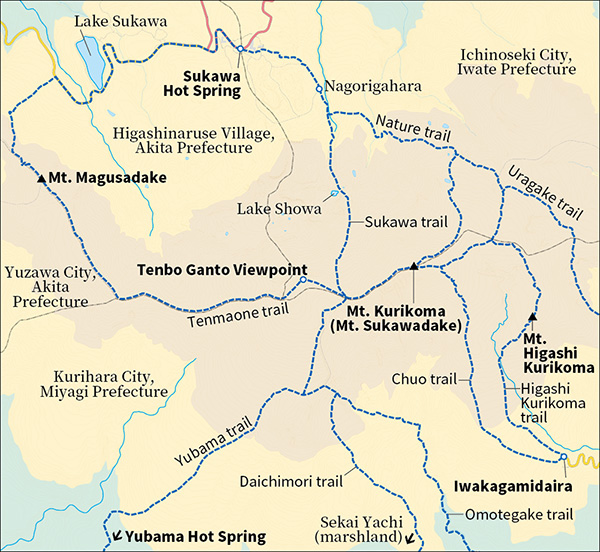
Summer time
Summer is the season of flowers at Mt. Kurikoma!
Enjoy the alpine vegetation that made Mt. Kurikoma one of Japan’s 100 most famous peaks for flowers as selected by Sumie Tanaka!
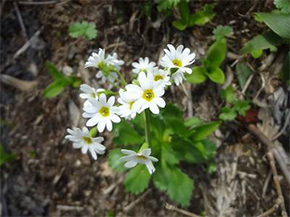
Primula nipponica that are members of the primrose family were the main reason why Sumie Tanaka selected Mt. Kurikoma as one of Japan’s 100 most famous peaks for flowers.
The some 150 species of alpine flora transform the mountain into a flower garden.
Mt. Kurikoma is easily accessible by the Tohoku Shinkansen. Be sure to visit in the early summer for the new budding greenery and later in the summer for alpine flora.
Check out the must-see charms of Mr. Kurikoma in the summer!
(Available only in Japanese)
Getting there
- Find out how long it takes to travel to Mr. Kurikoma.
- Tohoku Shinkansen
Approx. 2 hours from Tokyo Station to Kurikoma-Kogen Station.
After getting off at Kurikoma-Kogen Station, approx. 60 minutes by car to Iwakagamidaira.
About 2 hours from Tokyo to Ichinoseki Station.
From Ichinoseki Station, it takes about 90 minutes by bus to Sukawa Hot Spring.
Inquiries credit
- Kurihara Tourism and Products Association
- 284-3 Shiwahime Shinkumaya, Kurihara City,
Miyagi Prefecture 989-5612
Tel. +81-228-25-4166
- Ichinoseki Tourist Association
- 1F, Chamber of Commerce and Industry,
1 Ekimae, Ichinoseki City,
Iwate Prefecture 021-0867
Tel. +81-191-23-2350
Official tourism website of Ichinoseki (Iwate Prefecture)
Ichinoseki Sightseeing Navigator “Ichitabi”
http://www.ichitabi.jp/
(Available in English and Traditional Chinese)
- Yuzawa City (Akita Prefecture)
- Yuzawa City Hall 1-1 Satake Town, Yuzawa City,
Akita Prefecture 012-0824
Tel. +81-183-73-2111 (main line)
Tourist information
http://www.city-yuzawa.jp/kanko/index.html
(Available only in Japanese)
- Higashinaruse Village (Akita Prefecture)
- 30-1 Tagonai Senninshita, Higashinaruse Village,
Ogachi District, Akita Prefecture 019-0801
Tourism website for Higashinaruse Village (Akita Prefecture)
http://www.higashinaruse.com/kanko/index.html
(Available only in Japanese)


